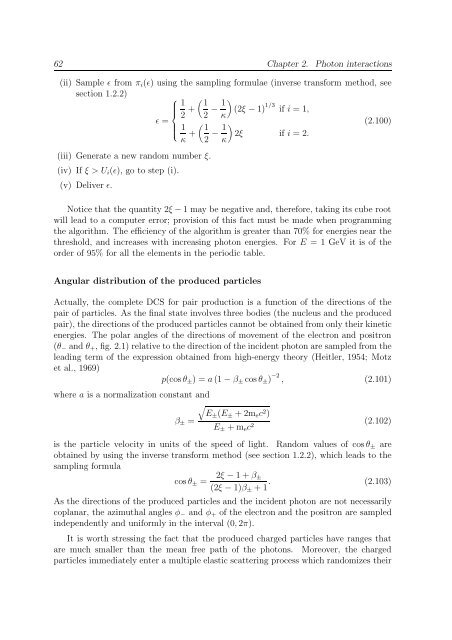PENELOPE 2003 - OECD Nuclear Energy Agency
PENELOPE 2003 - OECD Nuclear Energy Agency
PENELOPE 2003 - OECD Nuclear Energy Agency
You also want an ePaper? Increase the reach of your titles
YUMPU automatically turns print PDFs into web optimized ePapers that Google loves.
62 Chapter 2. Photon interactions<br />
(ii) Sample ɛ from π i (ɛ) using the sampling formulae (inverse transform method, see<br />
section 1.2.2)<br />
⎧ (<br />
1 1<br />
⎪⎨ 2 + 2 − 1 )<br />
(2ξ − 1) 1/3 if i = 1,<br />
κ<br />
ɛ = (<br />
1 1 ⎪⎩<br />
κ + 2 − 1 )<br />
(2.100)<br />
2ξ if i = 2.<br />
κ<br />
(iii) Generate a new random number ξ.<br />
(iv) If ξ > U i (ɛ), go to step (i).<br />
(v) Deliver ɛ.<br />
Notice that the quantity 2ξ − 1 may be negative and, therefore, taking its cube root<br />
will lead to a computer error; provision of this fact must be made when programming<br />
the algorithm. The efficiency of the algorithm is greater than 70% for energies near the<br />
threshold, and increases with increasing photon energies. For E = 1 GeV it is of the<br />
order of 95% for all the elements in the periodic table.<br />
Angular distribution of the produced particles<br />
Actually, the complete DCS for pair production is a function of the directions of the<br />
pair of particles. As the final state involves three bodies (the nucleus and the produced<br />
pair), the directions of the produced particles cannot be obtained from only their kinetic<br />
energies. The polar angles of the directions of movement of the electron and positron<br />
(θ − and θ + , fig. 2.1) relative to the direction of the incident photon are sampled from the<br />
leading term of the expression obtained from high-energy theory (Heitler, 1954; Motz<br />
et al., 1969)<br />
p(cos θ ± ) = a (1 − β ± cos θ ± ) −2 , (2.101)<br />
where a is a normalization constant and<br />
√<br />
E ± (E ± + 2m e c 2 )<br />
β ± =<br />
(2.102)<br />
E ± + m e c 2<br />
is the particle velocity in units of the speed of light. Random values of cos θ ± are<br />
obtained by using the inverse transform method (see section 1.2.2), which leads to the<br />
sampling formula<br />
cos θ ± = 2ξ − 1 + β ±<br />
(2ξ − 1)β ± + 1 . (2.103)<br />
As the directions of the produced particles and the incident photon are not necessarily<br />
coplanar, the azimuthal angles φ − and φ + of the electron and the positron are sampled<br />
independently and uniformly in the interval (0, 2π).<br />
It is worth stressing the fact that the produced charged particles have ranges that<br />
are much smaller than the mean free path of the photons. Moreover, the charged<br />
particles immediately enter a multiple elastic scattering process which randomizes their
















